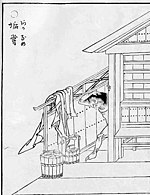Akaname

The akaname (垢嘗) is a demon or yōkai from Japanese folklore. Akaname means filth licker in Japanese; aka is an homonym for red and filth, so the akaname is often described as being red in colour.[2]
The akaname is the "personification of the fear of using a dark bathroom late at night".[2] It is said to come out at night to lick up the grime and dirt that accumulates in unclean bathrooms.[2]
Akaname in art
Toriyama Sekien's 1776 work, Gazu Hyakki Yagyō (Pictures of Demons' Nocturnal Stroll)[3] includes an early line drawing of an akaname,[1] possibly based on Kokon Hyaku Monogatari Hyōban (古今百物語評判; An Evaluation of One Hundred Strange and Weird Tales of Past and Present),[citation needed] a tale from the Edo period.[3] Sekien included no explanation for the drawing.[citation needed]
In other media
"Filthlicker (Akaname)" is a song by the UK heavy metal band Sa-da-ko from their 2013 album, Awakenings.
In the video game The Legend of Zelda: Majora's Mask, there is a creature who lives in the hotel toilet in Clock Town that may or may not be inspired by this folk legend.
It has also spawned a fandom as a creature in the Monster Girl Encyclopedia, written by Japanese author Kenkou Cross.
In the Lost Girl episode "Big in Japan" (season 5, episode 3) a character almost becomes an akaname.
In an episode of Yo-Kai Watch the protagonist, Keita, ends up possessed by an Akaname and has an uncontrollable urge to lick food clean and eventually people's hair. It's only after his friend Fumi shares her salty-sweet candy with him that the Akaname leaves him alone and goes down to the store to buy more candy.
Akaname appear in the Glu Mobile videogame Samurai vs Zombies Defense, in which they fight for the zombies and use their tongues to attack.
References
- ^ a b Toriyama, Sekien (July 2005). Toriyama Sekien Gazu Hyakki Yagyō Zen Gashū (in Japanese). Tokyo: Kadokawa Shoten Publishing Co., Ltd. pp. 10–65. ISBN 4-04-405101-1.
- ^ a b c Yoka, Hiroko (2008). Yokai Attack! The Japanese Monster Survival Guide. Tokyo: Kodansha International Ltd. pp. 82–85. ISBN 4-77-003070-3.
- ^ a b Reider, Noriko (2010). Japanese Demon Lore. U.S.A: Utah State University.
Further reading and listening
- Gould, Robert Jay (2003). Japan Culture Research Project.
- Stevens, Ben (2009). A Gaijin's Guide to Japan: an Alternative Look at Japanese Life, History and Culture. HarperCollins UK.
- Akaname Bandcamp
